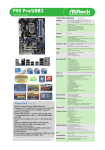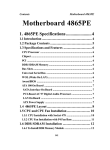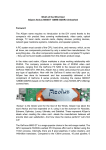Download Albatron PX915G Pro
Transcript
Albatron PX915G Pro Written by Stephen Friday, 04 September 2009 10:52 ..:: Introduction ::.. Our first experience with an Albatron motherboard was a good one, and came a few months back with their high-end i875P model, the PX875P Pro. In our time working with that motherboard, we found that the product package had its strong and weak points, namely that the included items were relatively few, but the documentation was excellent. The board featured a solid design, a fair BIOS, and an overzealous overclocking claim. Today, we’re taking a look at Albatron’s i915G entry, the PX915G Pro. This motherboard features some of the same strengths and weaknesses found by the PX875P Pro, but where have things improved? Has Albatron improved overclocking capabilities with the i915G board, namely can they compete with the big boys of the overclocking world? Read on to find out! ..:: PX915G Pro Specifications ::.. Processor - Designed for Intel® 90nm Prescott LGA775 Processors w/533/800MHz FSB - Supports Intel Hyper-Threading Technology Chipset 1 / 18 Albatron PX915G Pro Written by Stephen Friday, 04 September 2009 10:52 - North Bridge : Intel i915G South Bridge : Intel ICH6-R ITE IT8212F IDE RAID Controller Marvell 8100 Gigabit Ethernet Controller VIA 10/100 Ethernet Controller Realtek ALC880 HD Audio CODEC Memory - 4 DDR-I DIMM Slots - DDR-I 400/333MHz RAM - Max: 4GB Expansion Slots - 1 x PCI-Express x16 2 x PCI-Express x1 3 x PCI 3 x UDMA/133/100/66 1 x FDD 4 x SATA 8 x USB 2.0 (Total) 2 / 18 Albatron PX915G Pro Written by Stephen Friday, 04 September 2009 10:52 Back Panel I/O Ports - 1 x Parallel, 1 x Serial 1 x PS/2 Keyboard, 1 x PS/2 Mouse 6 x Audio I/O 1 x Video Output 4 x USB 2.0, 2 x RJ-45 Port ..:: PX915G Pro Packaging ::.. As we have seen in the past, the majority of Albatron’s motherboard products fall more towards the budgeted end of the consumer spectrum, so we weren’t expecting all too much out of the PX915G Pro’s package. I was initially expecting your general motherboard product package, with an expansion bracket here and there, but nothing of real substance besides the cabling and other must have components. Especially given that this is a heavily integrated motherboard, it is based off of the i915G chipset after all, I wasn’t expecting too much. In the end, that’s exactly what we ended up with. Unlike with the PX875P Pro, several items we would expect on say, Albatron’s i925X motherboard, weren’t included, but that was what we thought we’d find. To start things off, we have the various documentation items for the PX915G Pro. Much like what we often see from the likes of Gigabyte in the past, and ABIT as of recent times, Albatron has chosen to include a fold-out, color installation guide. This guide has a large portrayal of the motherboard on the front cover with all of the vital components and connectors labeled. As we progressed through reading the installation guide, we found that it is quite good in making sure to cover all of the important points that a first time builder would need to know. The guide goes over all installation procedures ranging from the processor and jumper configuration, to simple 3 / 18 Albatron PX915G Pro Written by Stephen Friday, 04 September 2009 10:52 tasks such as power supply and hard drive connections. Granted, for the experienced user this guide will be overlooked, but for a first time user this is a necessity. The next item that we found was yet another feature that we like to see included with motherboards, that being a large sticker featuring a layout of the board. This sticker can be affixed to the interior of the case, and is easily accessible if needed. The sticker displays locations and pin diagrams for all of the major headers and jumpers located on the PX915G Pro’s PCB. Finally, we have the manuals. Once again, this is one aspect where the Albatron product shines in that not only does the manual come in several languages, but it also manages to cover all of the most important aspects of the board, such as pin diagrams of headers, jumper setting data, excellent coverage of the various BIOS options, and excellent driver installation instructions. Albatron has also included an excellent user manual for configuration and proper usage of the ITE IDE RAID controller as well. As far as hardware related inclusions go, the PX915G Pro came with the bare minimum. We’ve got a single Serial ATA data cable, as well as a single Molex power adapter for a Serial ATA device. There are three IDE cables that have been included, one for use with the ICH6’s native IDE support, and two additional cables for the ITE RAID controller. We also have the usual rear I/O panel, as well as an additional expansion bracket featuring four additional USB 2.0 capable ports. If you remember back to our review of the PX875P Pro, Albatron actually didn’t include a rear I/O panel, because they used the default layout for that board. Now that the PX915G Pro comes along with a custom I/O layout, they’ve include the required I/O panel. Overall, the PX915G Pro’s package has a strong point or two, as well as weak points. From a hardware item standpoint, we were a bit disappointed at the lack of some minor items such additional SATA data / power cables, especially given that the ICH6 Southbridge now supports four Serial ATA devices. In the past, manufacturers could get away with supplying only one cable, but now I’d like to see at least two included with the product packages. These are items won’t really cause the end price to skyrocket, so I would’ve liked to see those included to make the PX915G Pro a better bang for the buck. The documentation that Albatron has included on the other hand is superb. All of the various inclusions that Albatron has chosen to make provide a well rounded and detailed look at the capabilities and layout of the PX915G Pro and will make even a first time builder’s life a little easier. ..:: PX915G Pro Layout: Socket Area ::.. 4 / 18 Albatron PX915G Pro Written by Stephen Friday, 04 September 2009 10:52 Now that we’ve had a chance to examine the product package, it’s time we took a good look at the board design and layout scheme. Just to re-cap our new stance on design, here’s a copy of our previous statement…With these new chipsets from Intel, I have noticed that the motherboard surface itself has become far more cluttered, mainly due to voltage generation devices necessary for the DDR-II modules and PCI-Express. As we progress around this motherboard, as well as many in the future, we will undoubtedly see the days of extremely clean and clear PCB surfaces head the way of the dodo. Because of this, we’ve developed a new modus operandi when evaluating the layout of the motherboard. Instead of going merely for cleanliness, we’ll be putting more of an impact on components locations and orientations for the end user. Clean PCB’s are nice, but locations and ease of access are going to be far more important with these motherboards. The Socket T is oriented lengthwise from East to West across the motherboard. Due to the much improved mounting mechanics for the new LGA 775 processors, Intel has done away with the large retention bracket that was needed on the older Socket 478 implementations. The new mounting method simply requires pushing some pins through the four mounting holes, and you’re done. Around the Socket T, we find that Albatron has put to use the low profile component zones for the core voltage power supply. Albatron has implemented a three-phase design for the PX915G Pro, as can be seen with the three side-mounted inductors, complete with their own encasings. This is the first three-phase power solution that we have seen so far for any of the LGA775 motherboards. We’ll see later on if it has an effect upon overall stability or not. The components that make up the processor portion of the PX915G Pro deal with the core voltage supply. The main control chips are manufactured by Analog Devices, along with the three MOSFET drivers. Unlike some of the other LGA775 motherboards we’ve dealt with over the past month or so, Albatron has not positioned the four-pin 12V core voltage supply connector in the upper left corner of the board. Instead, Albatron has shifted the secondary core voltage connection further down the board, towards the bottom end of the series of capacitors, MOSFET’s and inductors. This was the typical location on i875P / i865PE motherboards, and we’ve seen this used twice now on LGA775 motherboards. 5 / 18 Albatron PX915G Pro Written by Stephen Friday, 04 September 2009 10:52 Other than these core electrical components, the processor portion of the PX915G Pro is quite clean. Albatron has been able to implement a solid three-phase power solution for the PX915G Pro with high quality, ultra-low ESR capacitors, as well as high quality control components from Analog Devices. We’ve seen most high performance motherboards running off four-phase solutions, so we’ll see how well this three-phase solution can handle Intel’s Pentium 4 560 processor, a power hog to say the least. The reason we’ve seen shifts to four-phase solutions is due to the power draw from these new processors. By increasing the number of phases, the processor can obtain a cleaner and steadier voltage, providing for solid power delivery. ..:: PX915G Pro Layout: Northbridge Area ::.. The PX915G Pro follows in line with previous Albatron Northbridge coolers, given that they have mostly been passive solutions. With these new Northbridge chips, we’ve seen far more manufacturers throwing in active cooling solutions, and they are needed. Throughout our testing, we found that this cooler alone, with no cooling fan was rather inadequate. As the analogy goes, a warm heatsink is a working heatsink, but a hot heatsink is an overworked heatsink. This cooler managed to get a little more than hot during normal system operation, even under open case, low ambient temperature situations. With no airflow to go over the Northbridge other than hot air being expelled from the CPU heatsink, this heatsink is overworked. This heating problem will certainly affect overclocking capabilities no doubt, especially with Albatron pressing the fact that upping the Northbridge voltage can help overclocking. Upping the Northbridge voltage might help, but when you’re dealing with an already hot chip, raising the voltage isn’t the brightest idea. The area to the left of the i915G Northbridge chip is quite clean featuring two fan power headers, as well as the PC915G Pro’s secondary 12V core voltage power supply connection. I still prefer to see this located farther up the PCB for airflow purposes, though with the slim size of the cable this implementation works nicely as well. The four-pin fan power connection comes in next, followed by the three-pin power connection for a rear exhaust fan. This three-pin connection is located along the top edge of the x16 PCI-Express slot, whereas the four-pin connector is closer to the processor socket. Other than a few additional resistors, capacitors, 6 / 18 Albatron PX915G Pro Written by Stephen Friday, 04 September 2009 10:52 inductors, and other electrical items, this portion of the board is once again quite clean, though something needs to be done about the Northbridge heatsink if you ask me. ..:: PX915G Pro Layout: Expansion Area ::.. The expansion slot portion of the PX915G Pro features a single x16 PCI-Express slot, along with two x1 PCI-Express slots. At the bottom of the board, we also find three regular PCI slots. This is generally going to be the typical setup found on most of these i925X and i915P motherboards for some time to come. We’ve seen boards with three x1 PCI-Express slot and two PCI slots as well. Due to the lack of PCI-Express products out there at this time that use the x1 connection, or any other besides x16, we’ll see mostly x1 and x16 connections for some time. The majority of the components in this area of the PCB are, as always, located along the rear edge of the motherboard. At the top of this section, right under the rear I/O panel we first find the main component dealing with the PX915G Pro’s onboard audio, the Realtek ALC880 HD Audio CODEC. The ALC880 offers full 7.1 channel audio support, features two 24-bit DACs and three 20-bit stereo ADCs for high quality, high resolution audio, and also features 32-bit, 96kHz support for both input and output S/PDIF connections. Interestingly enough, we find no auxiliary four-pin audio connections, or a front panel audio header located near the CODEC. Next up, we find a feature for the PX915G Pro that was built into the GA-8ANXP-D reviewed last week, two separate Ethernet controllers. First off, we find the same Marvell Gigabit Ethernet chip. Albatron has been able to implement this chip into the PCI-Express bus, rather than using the aging PCI bus. We’ve seen some manufacturers such as ABIT attempt to free up some PCI-Express lanes by implementing Gigabit solutions into the PCI bus, but this will hamper 7 / 18 Albatron PX915G Pro Written by Stephen Friday, 04 September 2009 10:52 performance and throughput in the end, so it’s nice to see Albatron tackle their Gigabit support by throwing the device on the PCI-Express bus. Located right below the Marvell chip, we next come across the second Ethernet controller chip, this time manufactured by VIA. This VIA Ethernet controller is only a 10/100 chip, so Albatron has chosen to implement this chip into the regular PCI bus. We’ve seen this done once before with the GA-8ANXP-D motherboard from Gigabyte, so I’m thinking this is going to become a more popular implementation in upcoming motherboards based off of these new Intel chipsets. The area around both of these chips is clean, each having its own 25MHz clock crystal. Lastly, we find an array of headers and connections that have been placed beneath the last PCI slot along the bottom edge of the PX915G Pro’s PCB surface. The system BIOS chip is located in the bottom left hand corner of the board, and is soldered directly to the motherboard itself. As far as the headers and connections go, we now find several of the audio related headers that we expected to find by the ALC880 CODEC. Albatron has heard our cry and moved all of the primary and secondary audio headers to the bottom portion of the motherboard. This location for the CD audio, S/PDIF header, MIDI Game Port, and Front Panel Audio headers allows for easy cable routing, and prevent cables from being run throughout the case interior, thereby creating a possibility for dead air zones. ..:: PX915G Pro Layout: Southbridge & Memory Area ::.. The Southbridge portion of the motherboard is a little on the cluttered side, though due to the lack of any additive components for the PX915G Pro, this area is far cleaner than some of the boards we have dealt with thus far. From a design vantage point, the overall layout of these components has been done very well, and it is clear that quite a bit of time went into making sure that all of the most useful items were located in readily accessible areas, all while keeping 8 / 18 Albatron PX915G Pro Written by Stephen Friday, 04 September 2009 10:52 the layout crisp and clean. The first component we find is located near the edge of the PCI slots, the ITE IDE RAID controller chip. As we’ll soon see, this ITE chip provides support for two ATA133/100/66/33 hard drives in the various RAID modes. In the bottom right hand corner of the PX915G Pro’s PCB, we find a series of important items, ranging from large to small. To start things off, the first things that will jump out at you are the yellow IDE connectors. These two connectors are controlled by the ITE IDE RAID controller, as the ICH6R only support one native ATA100/66/33 connection. Below these two connectors, we find an array of headers, most providing for front panel connections to switches, LED’s, case intrusion detectors, and more. There is also an IrDA header, as well a as a three-pin power connection for a front system intake fan. As we progress further up the PCB, the next components that we’ll come across are all controlled via the ICH6R Southbridge. The ICH6R Southbridge chip is covered by a gold anodized, passive heatsink solution. With these Southbridge heatsinks, we’ve seen some pretty interesting designs. Albatron has included a cutout of the bird insignia they use, which ads a little flavor to the heatsink, though this can’t really be seen in a mounted situation. To the right of the ICH6R, we find all four of the Serial ATA headers, as well as the Clear CMOS jumper, system battery and finally, the IDE connector. To the left of the heatsink, we find both of the yellow USB 2.0 headers which allow for connection of the included expansion bracket to bring USB 2.0 support to a maximum, should the end user require all of those ports. Finally, we come across the DIMM slots. Here, we can see that, as is typical for DDR motherboards, each channel has been represented with a different DIMM color. Along the right side of the DIMM slots, we find the new 24-pin ATX connection. These PSU’s are still quite difficult / expensive to come by at this point, but the PX915G Pro is backwards compatible with the PSU you’re using today so you’ll have no problems with the switch. All that need to be done is mount the 12V ATX connector so the bottom four pins are left unconnected. Gigabyte made a wise choice by placing a sticker over the bottom four pins just in case, and we’d like to see other manufacturers do this just for added safety for those who dislike reading manuals. This area also houses the Winbond Super I/O chip for control over the legacy I/O ports, as well as the system monitoring responsibilities. One fact is clear when you take an overall look at the PX915G Pro’s PCB, that fact is that it is readily obvious Albatron put some serious thought into the layout of the system components. Virtually every item that we look for as far as determining design quality goes, Albatron has successfully implemented into the PX815G Pro. Even when we factor in the small things that weren’t done due to design constraints, we still find an excellent motherboard. Unlike many 9 / 18 Albatron PX915G Pro Written by Stephen Friday, 04 September 2009 10:52 manufacturers, Albatron has not thrown the floppy connector down to the bottom of the PCB, rather they have left it near the ATX power connection higher up on the board. This greatly helps airflow into the case, and over the graphics card, RAM, and processor. RAM can also be added and removed without having to remove the PCI-Express graphics card, a problem that we’ve already seen on some i925X / i915P/G motherboards. Overall, Albatron has done an excellent job with the PX915G Pro’s design. ..:: PX915G Pro System BIOS ::.. As far as the PX915G Pro’s BIOS goes, Albatron has opted to go with a Phoenix Award BIOS setup, a setup that is more familiar in the OEM world than what we normally come across here in the enthusiast community. This BIOS setup is also common on Intel brand motherboards, which are, of course, geared more towards the mid-range consumer than an enthusiast. When the BIOS is initially entered into, there is a horizontal selection of menus ranging from the standard “Main” where simple selections are shown, to “Defaults” which allows for selection of setting to Normal of performance settings. These settings are similar, if not identical, to what we see in other BIOS’ only presented in a new way. The first menu that we’ll be diving into is labeled as “Advanced”. Upon entering this menu, we find a wide array of settings as well as four submenus available. The top setting selections are typical of this portion of the BIOS, as they control both boot order and boot priority for the given devices. There are four available submenus, each covering one specific aspect of the PX915G Pro’s capabilities. These submenus are labeled “Advanced BIOS Features”, “Advanced Chipset Features”, “PnP/PCI Configurations”, and “Frequency/Voltage Control”. Within the BIOS feature submenu, we find that here the user is given the option to enable an array of options for the PX915G Pro. Some of these options are whether to enable or disable 10 / 18 Albatron PX915G Pro Written by Stephen Friday, 04 September 2009 10:52 the on die L1 & L2 Cache, Hyper-Threading Technology, Quick POST, and HDD S.M.A.R.T. capabilities. The Advanced Chipset Features submenu houses all of the important memory timing options. While Albatron allows for the standard memory timings to be manually adjusted, there are no other tweaking options available that would make the PX915G Pro a standout for tweaking options. Albatron offers the standard CAS, RAS to CAS, RAS to Precharge, and Precharge timing selections. The last submenu that we’ll be covering from the “Advanced” portion of the BIOS is the “Frequency/Voltage Control” submenu. This portion of the BIOS will certainly be home to the overclocker and performance enthusiast. Starting off from the top, we see that Albatron has allowed for fixed PCI and PCI-Express clocks. I wouldn’t suggest toying too much with the PCI-Express lock as we’ve heard of problems being brought about due to a locked bus speed. Below, we find the option to determine the system memory speed, whether that be DDR333 or DDR400, depending on your RAM of use. Towards the bottom, we see the options to adjust the FSB and Multiplier, though virtually all of you out there besides those that manage to get hold of an unlocked chip will not be able to use this Multiplier option. Located in the block below these items relating to frequency settings, we find all of the voltage adjustments that Albatron has made available. Albatron offers a solid range of preset speeds for each of the busses. The DRAM can be adjust up to +.4V in .1V increments, while the Northbridge voltage can also rise a maximum of +.3V, in .1V increments. Albatron offers an incredible range of VCore options, but beware, if you undervolt your processor, do NOT set the system to the voltage you’d like, set it roughly .5V higher than you’d like to obtain the proper voltage. Next up, we have the Peripherals menu. I can’t really address this menu all that much as it is self explanatory. The peripherals menu houses all of the options to control enabling or disabling integrated devices such as LAN, Audio, Serial Ports, Parallel Ports, and on the occasion the kitchen sink as well. Okay, maybe not quite that much but you get the point. If you wish to enable or disable any feature of the PX915G Pro, this is where you’ll need to head in order to do so. Sound good? Let’s move on. The last menu that we’ll be covering is yet another window that really need no introduction, that being the HW Monitor menu. This menu has two options available for a warning signal when the case has been opened, and another for the CPU FAN temperature. This window shows off the various temperature readings given by the motherboard, as well as fan RPM and voltage readings. With the PX875P Pro, we found the onboard readings to be way off as they virtually never changed, however Albatron has improved this with the PX915G Pro which appears far 11 / 18 Albatron PX915G Pro Written by Stephen Friday, 04 September 2009 10:52 more accurate for readings. Overall, the Albatron PX915G Pro ships with a solid BIOS, excelling in some aspects, while in others it is a bit dry. We really didn’t find many more advanced options for memory tweaks, the only other option besides lowering the timings was upping the Northbridge voltage to get more MHz on the FSB. Albatron has come a long way since the PX875P Pro with their voltage offerings, especially for the VCore. The PX875P Pro really disappointed us when it came to the limited overclocking options, but the PX915G Pro is excellent in this aspect. I was happy to see options to control the PCI and PCI-Express bus speeds, but over the past few weeks we’ve seen manufacturers remove the PCI-Express option because of reported problems with overclocking and stability on a set PCI-Express bus. Albatron also offers a nice range for upping the Northbridge voltage, although as you’ll soon hear about, this isn’t the best idea with the PX915G Pro. ..:: PX915G Pro Overclocking ::.. Our overclocking experiences with the Albatron PX915G Pro were mixed. At the default Northbridge voltage, we were only able to obtain a stable overclock in the area of 235MHz for the FSB. This is a far cry from where we’ve seen other manufacturers take their boards on a stock voltage. As we slowly upped the voltage though, we were able to attain higher speed settings for the FSB, but at a serious cost. We were able to hit 252MHz FSB with the PX915G Pro, but only when we had the Northbridge set to +.3V. We already have discussed the temperature at which the passively cooled heatsink runs, but it’s even worse with +.3V. This might not seem like much, but it’s a 20% increase in voltage over the standard application. We took out our external temperature gauge and found that near the core, the Northbridge heatsink was hitting 65C! Clearly, if you need to run at this high a voltage and temperature to attain a solid overclock, you need to re-think what you’re doing. Adding on .1V to the NB allowed for a 240MHz FSB, and adding .2V allowed for a 246MHz FSB. Whether or not you’re willing to deal with the heat is a different story, but if you plan on buying this board and overclocking, get some cool air flowing over that Northbridge pronto! 12 / 18 Albatron PX915G Pro Written by Stephen Friday, 04 September 2009 10:52 ..:: SiSoft SANDRA ::.. To start off today’s performance testing results, we’re going to cover SiSoftware’s SANDRA benchmarking suite. The first benchmark that we ran was to determine Arithmetic performance of the PX915G Pro in comparison to an array of i925X and i915P motherboards. For our Arithmetic results, we see that as far as ALU goes, the PX915G Pro manages the best score of the bunch so far, coming in at 10019. One the FPU front, we see that the PX915G Pro puts up a decent score, but it falls back down to the bottom of the bunch. For our Multimedia results, we found the PX915G Pro coming in second for ALU performance, just behind the GA-8ANXP-D. The story is repeated once again when it comes to FPU Multimedia performance. Finally, we have the Memory benchmark. As expected, the PX915G Pro falls right in line with the ABIT AG8, which is powered by the i915P chipset. Both boards run even matched for memory bandwidth according to SANDRA. ..:: MBReview PriBench ::.. Using our very own in-house benchmark, MBReview PriBench uses a computationally intensive algorithm to compute several hundred millions of prime integers. Unlike other synthetic benchmarks which rely on additional components within a computer system like the hard drive, PriBench does not rely on any of these exterior devices for the tests. PriBench is a system level benchmark, solely utilizing the performance of the processor and memory subsystem. It also focuses on comparing processor architectures and technologies and then seeing how much a core clock and/or FSB speed increase can be beneficial to the system. Our program is extremely accurate as we have witnessed time fluctuations of approximately .05 - .10 seconds. On the PriBench front, we can see that the Albatron PX915G Pro bodes well against the competition, falling in line right behind the i925X powered Gigabyte GA-8ANXP-D. The PX915G Pro is able to surpass ABIT’s AG8 which also posted some strong numbers, as well as the 13 / 18 Albatron PX915G Pro Written by Stephen Friday, 04 September 2009 10:52 “superior” i925X / DDR-II powered motherboards. One would expect the DDR-II powered motherboards to post up some better scores, but we’re still seeing strong performance coming out of the i915P/G chipsets even with only having DDR-I support. I would suspect that this trend will continue, thought it should get interesting to see how these i915P/G retail boards fare with DDR-II instead of DDR-I. It’s possible we could see slower times posted, but for now that’s mere speculation. ..:: ScienceMark 2.0 ::.. Next in line for our benchmarking results, we find ScienceMark 2.0. For this benchmarking suite, we decided to take a look at the performance results achieved with MemBench to analyze latency times as well as bandwidth. As we saw with the SANDRA results a little earlier, the PX915G Pro manages to put up a slightly better score than that of the ABIT AG8. Both of these boards fall behind the DDR-II powered motherboards by a fair margin of 10% or so. Latency and cycle wise, the PX915G Pro is pretty much even with the AG8. The PX915G Pro posts a hairline lead for latency time, though both boards come in with matched cycles. Both the i915P/G boards come in with latency times roughly 7% slower than those posted by the DDR-II powered boards. ..:: FutureMark 3DMark2003 ::.. The next benchmark that we’ll be covering from a gaming aspect is that of FutureMark’s 3DMark 2003. For our 3DMark2003 results, we see the ABIT AG8 actually posting a slightly 14 / 18 Albatron PX915G Pro Written by Stephen Friday, 04 September 2009 10:52 better score than the Albatron PX915G Pro. Heading into this benchmark, I was expecting to see the opposite happen, with the Albatron board holding a small lead over the ABIT board, but alas things didn’t turn out that way. These two boards could battle back and forth for the remaining benchmarks, but I suspect the PX915G Pro will come out on top most. ..:: AquaMark 3.0 ::.. To start off the gaming related synthetic benchmarks, we’re going to cover results that we attained from AquaMark 3.0. This is a gorgeous benchmark and can place some serious strain on any system. For our benchmarking purposes, we ran the default test at 1024 x 768 x 32 with no anti-aliasing or anisotropic filtering enabled. Much as I expected heading into this benchmark, we find the PX915G Pro taking a miniscule performance lead of roughly .1% over the ABIT AG8. This benchmark still belongs to the Gigabyte GA-8ANXP-D which manages a three frame per second lead over both the i915P/G motherboards. ..:: Quake III Arena ::.. The next of our gaming oriented benchmarks is the famed Quake III Arena. In order to remove any sort of graphics bottleneck from our results, we chose to go with the standard 640 x 480 resolution for our tests. As far as QIIIA performance goes, the PX915G Pro is able to once again jump ahead of the ABIT AG8, as I was expecting to see happen. We’re seeing a performance jump just shy of 1% for 16-bit performance, but only a mere .2% for 32-bit. Needless to say, once error is factored in here we’re once again seeing two motherboards running in a dead heat. Neither of the i915P/G motherboards is able to keep up with any of the 15 / 18 Albatron PX915G Pro Written by Stephen Friday, 04 September 2009 10:52 i925X, DDR-II boards that we have tested thus far. ..:: Unreal Tournament 2003 ::.. The last benchmark for the day, Unreal Tournament 2003, shows us some very interesting results. For this test, we once again ran the benchmark in 640 x 480 mode in order take the graphics card out of the equation as far as results go. In both sets of results above, we see that we’ll be ending our benchmarking tests today with a bit of a curve ball. This time, we see the ABIT AG8 overtaking the Albatron PX915G Pro for performance under both the BotMatch and FlyBy benchmarks. I was expecting to see the opposite happen, but given the close performance we’ve seen today between both of the i915 powered motherboards, it isn’t beyond belief, that’s for sure. ..:: PX915G Pro Review Conclusion ::.. Well, we’ve seen all that Albatron has to offer with their i915G offering, the PX915G Pro. This motherboard offered up a pretty decent feature set given the market it is going to be aimed at. Initially, we were concerned about system stability on the “Prescott” core processors due to their power draw as the PX915G Pro only features a three-phase power delivery scheme. Throughout our testing, we did not experience any stability problems that weren’t caused by our own mischief, also known as overclocking too far. The stability of the PX915G Pro at both stock and overclocked levels was right in line with the previous motherboards we’ve review, solid as a rock. The PX915G Pro’s package has a strong point or two points, as well as weak points. From a hardware item standpoint, we were a bit disappointed at the lack of some minor items such 16 / 18 Albatron PX915G Pro Written by Stephen Friday, 04 September 2009 10:52 additional SATA data / power cables, especially given that the ICH6 Southbridge now supports four Serial ATA devices. In the past, manufacturers could get away with supplying only one cable, but now I’d like to see at lease two included with the product packages. These are items won’t really cause the end price to skyrocket, so I would’ve liked to see those included to make the PX915G Pro a better bang for the buck. The documentation that Albatron has included on the other hand is superb. All of the various inclusions that Albatron has chosen to make provide a well rounded and detailed look at the capabilities and layout of the PX915G Pro and will make even a first time builder’s life a little easier. One fact is clear when you take an overall look at the PX915G Pro’s PCB, that fact is that it is readily obvious Albatron put some serious thought into the layout of the system components. Virtually every item that we look for as far as determining design quality goes, Albatron has successfully implemented into the PX815G Pro. Even when we factor in the small things that weren’t done due to design constraints, we still find an excellent motherboard. Unlike many manufacturers, Albatron has not thrown the floppy connector down to the bottom of the PCB, rather they have left it near the ATX power connection higher up on the board. This greatly helps airflow into the case, and over the graphics card, RAM, and processor. RAM can also be added and removed without having to remove the PCI-Express graphics card, a problem that we’ve already seen on some i925X / i915P/G motherboards. Overall, Albatron has done an excellent job with the PX915G Pro’s design. The PX915G Pro ships with a solid BIOS, excelling in some aspects, while in others it is a bit dry. We really didn’t find many more advanced options for memory tweaks, the only other option besides lowering the timings was upping the Northbridge voltage to get more MHz on the FSB. Albatron has come a long way since the PX875P Pro with their voltage offerings, especially for the VCore. The PX875P Pro really disappointed us when it came to the limited overclocking options, but the PX915G Pro is excellent in this aspect. I was happy to see options to control the PCI and PCI-Express bus speeds, but over the past few weeks we’ve seen manufacturers remove the PCI-Express option because of reported problems with overclocking and stability on a set PCI-Express bus. Albatron also offers a nice range for upping the Northbridge voltage, although as you’ll soon hear, this isn’t the best idea with the PX915G Pro. Our overclocking experiences with the Albatron PX915G Pro were mixed. At the default Northbridge voltage, we were only able to obtain a stable overclock in the area of 235MHz for the FSB. This is a far cry from where we’ve seen other manufacturers take their boards on a stock voltage. As we slowly upped the voltage though, we were able to attain higher speed settings for the FSB, but at a serious cost. We were able to hit 252MHz FSB with the PX915G Pro, but only when we had the Northbridge set to +.3V. We already have discussed the temperature at which the passively cooled heatsink runs, but it’s even worse with +.3V. This might not seem like much, but it’s a 20% increase in voltage over the standard application. We 17 / 18 Albatron PX915G Pro Written by Stephen Friday, 04 September 2009 10:52 took out our external temperature gauge and found that near the core, the Northbridge heatsink was hitting 65C! Clearly, if you need to run at this high a voltage and temperature to attain a solid overclock, you need to re-think what you’re doing. Adding on .1V to the NB allowed for a 240MHz FSB, and adding .2V allowed for a 246MHz FSB. Whether or not you’re willing to deal with the heat is a different story, but if you plan on buying this board and overclocking, get some cool air flowing over that Northbridge pronto! In the end, Albatron has brought a solid i915G motherboard to the market with their PX915G Pro. Given that this board features integrated video (which we’ll be covering more in depth as we test more i915G motherboards), it isn’t going to be the primary choice for the overclocking and enthusiast community. This board offers up all that is needed for the market it is targeted at, though I wish Albatron would include some extra items in with their packaging. Albatron offers up superior documentation with all of their products, but sometimes the package can be lacking, i.e. the PX915G Pro only comes with one Serial ATA data cable. The main strength of the PX915G Pro is its solid performance, and excellent design. The downsides though, fall under overclocking and BIOS tweaks. Although there are enough tweaks to please most users, high-performance users looking for an i915G option might want to look at other options first if memory adjustments are a requirement. The PX915G Pro also requires a high Northbridge voltage to attain high-end overclocking speeds, something that will only add serious heat to your system, and at 65C, lower the lifespan of your system should it be run under stressful situations. I suspect this board will run in the $140 range as are most i915G motherboard at this time. As we’ve yet to cover competing boards, I’ll leave he conclusion up to you. We’ll be comparing this board against Foxconn’s i915P and i915G boards soon, and we’ll then be able to further evaluate where it stands in the grand scheme of things. For now, it looks to be a solid board worthy of any use; it just might fall short on requirements for overclockers and performance gurus. 18 / 18







































